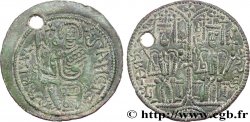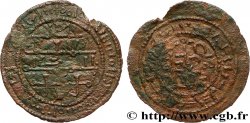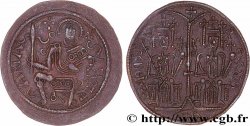E-auction 3-413 - fre_291030 - HUNGARY - KINGDOM OF HUNGARY - BELA III Follis, (MB, Æ 26) c. 1173-1196 Buda
You must signin and be an approved bidder to bid, LOGIN TO BID. Accounts are subject to approval and the approval process takes place within 48 hours. Do not wait until the day a sale closes to register. Clicking on « bid » constitutes acceptance of the terms of use of cgb.fr private e-auctions.
Bids must be placed in whole Euro amounts only. The sale will start closing at the time stated on the item description; any bids received at the site after the closing time will not be executed. Transmission times may vary and bids could be rejected if you wait until the last second. For further information ckeck the E-auctions F.A.Q.
NO BUYER'S FEE.
NO BUYER'S FEE.
| Estimate : | 150 € |
| Price : | 52 € |
| Maximum bid : | 55 € |
| End of the sale : | 04 April 2013 20:44:00 |
| bidders : | 6 bidders |
Type : Follis, (MB, Æ 26)
Date: c. 1173-1196
Mint name / Town : Buda
Metal : copper
Diameter : 26,1 mm
Orientation dies : 6 h.
Weight : 3,22 g.
Rarity : R1
Coments on the condition:
Belle patine foncée de médaillier. Faiblesse de frappe au niveau de la tête du roi assis à gauche
Obverse
Obverse legend : + SANCTA - MARIA.
Obverse description : La Vierge, nimbée, tient en main droite un sceptre en forme de lys, et sa main gauche appuie une sorte de reliquaire sur sa poitrine ; elle est assise sur un trône sans dossier, une croix dans le champ au dessus de sa tête.
Obverse translation : (Sainte Marie).
Reverse
Reverse legend : REX ST(EPHANU)S - N REX BELA.
Reverse description : Les rois assis sur un double trône sans dossier et tenant en main droite un globe crucigère sont Bela III et Etienne IV (1162-63) ou plus probablement Etienne III (soit pendant son règne entre 1164 et 1173, soit entre 1173 et 1196 lorsque Bela III règnant seul peut associer sur cette pièce le frère à qui il doit le pouvoir) ; entre les deux rois, une longue croix..
Reverse translation : (Roi Etienne – Roi Bela).
Commentary
Le follis est une copie des monnaies islamiques qui circulaient largement en Hongrie. Il est aussi connu sous le nom de follis (Imitation du trachy de billon scyphate byzantin).








 Report a mistake
Report a mistake Print the page
Print the page Share my selection
Share my selection Ask a question
Ask a question Consign / sell
Consign / sell
 Full data
Full data









